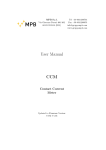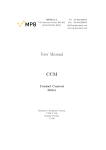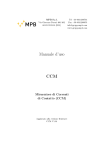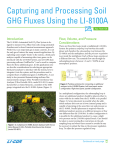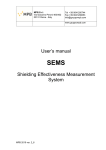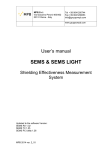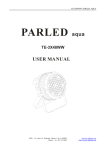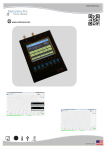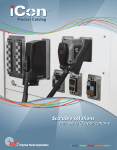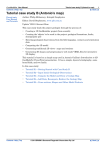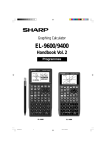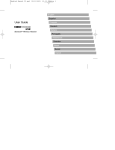Download User Manual
Transcript
MPB S.r.l. Tel +39 0641200744 Via Giacomo Peroni 400/402 Fax +39 0641200653 00131 ROMA (RM) [email protected] www.gruppompb.com User Manual CCM Contact Current Meter Updated to Firmware Version: CCM V1.01 SAFETY NOTES Read carefully before using the product MPB works to provide its customers with the best safety conditions available, complying with the current safety standards. The instrumentation described in this manual has been produced and tested in conditions that fully comply with the European standards. To maintain it in safe conditions, ensure the correct use of the product and prevent any danger, these general instructions must be fully understood and applied before any use. This product is intended for industrial environments and laboratories and should be used by authorized personnel only. MPB disclaims any responsibility for a dierent use of the device. Please use the device only after checking the presence and validity of the safety devices (e.g. breakers, dierential switches and the conformity of the grounding) For safety reasons, the the HAND measurement mode has to be done only after GROUND PLANE mode. The latter shall not exceed the limits dened by the 2013/35/EU regulation. II - User Manual CCM Declaration of Conformity (in accordance with the Directives: EMC 89/336/EEC and Low Voltage 73/23/EEC) This is to certify that the product: CCM (Contact Current Meter) complies with the following European Standards: Safety: CEI EN 61010-1 (2001) EMC: EN 61326-1 (2007) This product complies with the requirements of the Low Voltage Directive 2006/95/CE, and with the EMC Directive 2004/108/CE. MPB S.r.l. User Manual CCM - III IV - User Manual CCM Contents 1 2 3 4 General Information 1 1.1 Introduction . . . . . . . . . . . . . . . . . . . . . . . . . . . . . . 2 1.2 Description . . . . . . . . . . . . . . . . . . . . . . . . . . . . . . 2 1.3 Composition . . . . . . . . . . . . . . . . . . . . . . . . . . . . . . 2 1.4 Optional Kit . . . . . . . . . . . . . . . . . . . . . . . . . . . . . . 3 1.5 Front . . . . . . . . . . . . . . . . . . . . . . . . . . . . . . . . . . 4 1.6 Rear . . . . . . . . . . . . . . . . . . . . . . . . . . . . . . . . . . 5 1.7 Technical Specications . . . . . . . . . . . . . . . . . . . . . . . . 6 Principle of operation 7 2.1 Logic Schema 7 2.2 Measurements . . . . . . . . . . . . . . . . . . . . . . . . . . . . . 8 2.3 Contact Current . . . . . . . . . . . . . . . . . . . . . . . . . . . . 8 2.4 Safety 9 . . . . . . . . . . . . . . . . . . . . . . . . . . . . . . . . . . . . . . . . . . . . . . . . . . . . . . . . . . . . . . CCM Usage 11 3.1 Turn On . . . . . . . . . . . . . . . . . . . . . . . . . . . . . . . . 11 3.2 Standby Screen 12 3.3 Hand or GP . . . . . . . . . . . . . . . . . . . . . . . . . . . . . . 13 3.4 Bandwidth/Total . . . . . . . . . . . . . . . . . . . . . . . . . . . 14 3.5 First Use . . . . . . . . . . . . . . . . . . . . . . . . . . . . . . . . 14 3.6 CCM Menu . . . . . . . . . . . . . . . . . . . . . . . . . . . . . . . . . . . . . . . . . . . . . . . . . . . . . . . . . . 16 3.6.1 Regulation limits . . . . . . . . . . . . . . . . . . . . . . . 16 3.6.2 Beep on press . . . . . . . . . . . . . . . . . . . . . . . . . 17 3.6.3 Alarm . . . . . . . . . . . . . . . . . . . . . . . . . . . . . 17 3.6.4 Auto OFF . . . . . . . . . . . . . . . . . . . . . . . . . . . 17 3.6.5 Date & Time . . . . . . . . . . . . . . . . . . . . . . . . . 19 3.6.6 Contrast . . . . . . . . . . . . . . . . . . . . . . . . . . . . 19 3.6.7 Clear Data . . . . . . . . . . . . . . . . . . . . . . . . . . . 19 Data Download 4.1 Connect to PC 4.2 Data Format 21 . . . . . . . . . . . . . . . . . . . . . . . . . . . . 21 . . . . . . . . . . . . . . . . . . . . . . . . . . . . . 22 V CONTENTS 5 6 JIG - General Information 25 5.1 Introduction . . . . . . . . . . . . . . . . . . . . . . . . . . . . . . 25 5.2 Description . . . . . . . . . . . . . . . . . . . . . . . . . . . . . . 25 5.3 Composition . . . . . . . . . . . . . . . . . . . . . . . . . . . . . . 26 5.4 Kit Case . . . . . . . . . . . . . . . . . . . . . . . . . . . . . . . . 27 JIG - Functioning 29 6.1 Equipment . . . . . . . . . . . . . . . . . . . . . . . . . . . . . . . 29 6.2 Install the CCM on the JIG . . . . . . . . . . . . . . . . . . . . . 30 6.3 Ground Plane Test . . . . . . . . . . . . . . . . . . . . . . . . . 32 6.4 Hand Test . . . . . . . . . . . . . . . . . . . . . . . . . . . . . . 33 6.5 Certicate Measurements . . . . . . . . . . . . . . . . . . . . . . . 34 6.5.1 Low Band . . . . . . . . . . . . . . . . . . . . . . . . . . . 34 6.5.2 Medium Band . . . . . . . . . . . . . . . . . . . . . . . . . 34 6.5.3 High Band . . . . . . . . . . . . . . . . . . . . . . . . . . . 34 Figures List VI - User Manual CCM 35 Chapter 1 General Information Figure 1.1: CCM 1 1. General Information 1.1 Introduction CCM was designed to measure the contact current that may be generated when touching electrical/electronic equipment inside a radio frequency eld, in a fast and accurate way. 1.2 Description CCM (Figure 1.1) is a portable measuring device with more than one measurement mode. Depending on the needs, it can measure by means of the GROUND PLANE (and the related resistance for closing the circuit on the ground), or it can work without a cable, making use of the impedance level of the user through the conductive area on the handle. In the next chapters we will go more deeply into this subject. 1.3 Composition The base conguration of this device includes: • Rigid Case. • CCM. • 1,5 V Batteries (2 pcs.). • sma-sma Cable (M-M) (2 mt.); • Body Simulation Impedance (Z-2251). • USB Cable for PC Connection. • Ground Plane plate. • USB Key with: User Manual Data Sheet Calibration Certicate 2 - User Manual CCM 1. General Information 1.4 Optional Kit CCM-Kit of Calibration, including: • CCM-JIG • Resistances (R45) • RG316 cable (1 mt length) N(M)-sma(M) User Manual CCM - 3 1. General Information 1.5 Front In Figure 1.2 is shown the CCM front panel: On/O switch Micro USB connector Keyboard Figure 1.2: CCM front 4 - User Manual CCM 1. General Information 1.6 Rear In Figure 1.3 is shown the CCM rear panel: Measure Tip Measure trigger Ground connector Figure 1.3: CCM rear User Manual CCM - 5 1. General Information 1.7 Technical Specications Frequency Range Low band Medium band High band Frequency Response Low band Medium band High band Measurement range Low Band Level range Damage level Resolution Dynamic range @ 500Hz Linearity error @ 500Hz; 0,3...3 mA Medium band Level range Damage level Resolution Dynamic range @ 10kHz Linearity error @ 10Hz; 10...200 % High band Level range Damage level Resolution Dynamic range @ 10MHz Linearity error @ 10Mz; 12...120 mA Measurement modes Alarm sound Display Detectors Contact tip USB Interface Standards Operating Temperature Power supply Battery Operation Time Dimensions Weight Recommended Calibration Interval 6 - User Manual CCM 40 Hz to 2.5 kHz 2.5 kHz to 100 kHz 100 kHz to 110 MHz <+ − <+ − <+ − 1.5 dB 1.5 dB 1.2 dB 0.01 to 3 mA (ICNIRP limit 1 mA) 100 mA 1 nA 50 dB <+ − 1 dB 0 to 300 % (ICNIRP limit 1 to 40 mA) 500 % 1 nA 50 dB <+ − 1 dB 0.4 to 120 mA (ICNIRP limit 40 mA) 300 mA 10 nA 50 dB <+ − 1 dB Hand and Ground Programmable level Graphic LCD with led backlight true RMS Interchangeable Micro USB connector Directive 2004/40/EC +10 ◦ C to +40 ◦ C 2pcs AA Alkaline 24 hours 205 × 90 × 45 mm 200 g 24 months Chapter 2 Principle of operation 2.1 Logic Schema The schema shown in Figure 2.1 describes the CCM work ow: Hand Low Band Filter true RMS detector Display Ground Plane Medium Band Filter true RMS detector A/D µP MEM Tip High Band Filter true RMS detector Figure 2.1: CCM Block Diagram 7 USB 2. Principle of operation 2.2 Measurements The CCM digital nature allows it to measure contact currents through the true RMS (Root Mean Square) value for all analog signals from 40Hz. The RMS value of a waveform signal is equal to a DC current which provides the same power to the load. The signal measured by the TIP passes through the most suitable lter (Low, Medium and High), then arrives to the true RMS detector, that makes a conversion of the measured current to RMS . The equation is the following: s erms = 1 T Z T V(t)2 dt 0 The actual regulations denes the minimum requirements for the safety of workers in areas of risk, and the limit values for the exposure to contact current. 2.3 Contact Current The contact current ows when a person or an object serve as electrical conductors when reaching another metallic object immersed in an electromagnetic eld: the contact current is expressed in Amperes. The moment right after the contact can imply a discharge of associated currents (First attachment of 2013/35/EU). In the workplace, as well as in the world we live in, the electric and magnetic elds are always present and can have natural or articial origin. The natural electric elds are, for example, those produced by the accumulation of electric charges during a lightning, while the natural magnetic elds are those that are found in nature, such as the terrestrial one that orients the compass needle North-South. The electric and magnetic articial elds are produced by articial devices and systems, such as electrical equipment or systems for the distribution of electricity. The electromagnetic eld can be dened as a physical phenomenon given by the simultaneous presence of an electric eld and a magnetic eld. Moving from the source of the electromagnetic eld, the waves decrease in intensity, it is therefore clear that the intensity is maximum if there is a contact with the object or with the system which is generating the electromagnetic eld. A device with metallic shell, if immersed in an electromagnetic eld, can become a RF voltage carrier and can accumulate electrical charges. If you come into contact with the device without adequate protection, you can risk that the RF voltage discharges to ground owing through the limbs and the body. In this case, the electrical charges on the device, immersed in the electric eld through the operator's body, have generated a contact current. An electrical equipment not properly shielded can emit electromagnetic waves. When coming into contact with that machinery without adequate protection, even in this case there is a risk that the electromagnetic waves, owing through the limbs and the operator's body, can generate a contact current. 8 - User Manual CCM 2. Principle of operation 2.4 Safety The GP measurement mode has only been developed for safety reasons, since it does not guarantee reliable measurements. Also, for the operator's safety and security please make sure that, when performing GP measurements, the plate is set in the same position as the operator's. For more details please scroll down to 3.3 User Manual CCM - 9 2. Principle of operation 10 - User Manual CCM Chapter 3 CCM Usage 3.1 Turn On Release n◦ Figure 3.1: Turned On CCM When the CCM is turned on, it displays the MPB logo and the rmware version (Figure 3.1). After a few seconds a warning message will appear (as in Figure 3.2), and users have to declare to have read this manual and to be aware of the risks involved during the current measurement. In case of negative answer (by pressing DENY), the device will automatically turn o. 11 3. CCM Usage Figure 3.2: CCM Menu Once you accept the terms of use, the device will remain in the STANDBY mode, until you press the trigger to start a measurement. 3.2 Standby Screen In Figure 3.3 is shown the standby screen. On the top part, you will nd: • Battery indicator. • The Measurement Mode shows which kind of circuit is selected in that specic measurement session, and (we'll see that more accurately in next chapter) there are two dierent measurement modes: HAND for measurements that use the body impedance of the operator as a reference. GP (or GROUND PLANE ) for measurements that concern the supplied metal plate with a standardized impedance as a reference. • The State indicates to the user whether the device is ready to make a measurement or not. 12 - User Manual CCM 3. CCM Usage State Measurement Mode Battery level Figure 3.3: First Use 3.3 Hand or GP Please remember that the GP measurement mode does not guarantee reliable measurements due to safety reasons. Please scroll back to 2.4 for more details. In the main screen, the key on the right (in this specic case it can be or GP HAND ) allows the user to choose which circuit to use for the measurement (Figure 3.4). It's highly recommended to measure with the Ground Plane doing the before HAND measurement (so that, in extreme cases, a high voltage current will simply discharge on the ground). In the Hand measurement mode the CCM will consider the real impedance value of the human body. User Manual CCM - 13 3. CCM Usage Figure 3.4: Hand or GP 3.4 Bandwidth/Total the central key, BW/T, allows the user to choose the visualization mode: BANDWIDTH Display of the measurement divided by bands (or selective measurement), with the nal result expressed in mA. TOTAL Overall view of the measured value, in percentage, compared to the ICNIRP limit. You can nd an example of what happens in Figure 3.5. The starts at 40 Hz to 2.5 kHz (IC bound = 1 mA), while the Low band Filter High band Filter starts at 0.1 MHz to 110 MHz (IC bound = 40 mA). The value of the contact current in the range of frequencies ranging from 2.5 kHz to 100 kHz is determined by subtracting the total value from respectively the values of the LF and HF bands. For this reason it is suggested to make the measurement while displaying TOTAL and then check in BANDWIDTH at what frequency the limit has been exceeded. 3.5 First Use If the CCM has just been switched on (or if it's been more than one minute since the last measurement) it is in STANDBY mode. By pressing the trigger, the device performs a test to verify the eectiveness of the commutation of the 14 - User Manual CCM 3. CCM Usage Figure 3.5: BW/T selected relay and it actives the WAIT mode, which indicates that the device is loading. If the relay test has been successful, the message otherwise it will display READY is displayed, ERROR xx, where xx is the error code. Before pressing the trigger again, the operator will have to wait for the appearance of the READY message on the screen (Figure 3.6). From this moment on, the device is ready to perform the test in real-time. Figure 3.6: Ready for measuring User Manual CCM - 15 3. CCM Usage Before carrying out the measurement, please follow the instructions below: • Press the trigger to switch the instrument mode from STANDBY to READY. Only when the READY key appears (please do not press the trigger again) reach the equipment under test with the tip and, only after making contact, press the trigger to start the measurement. You can make single or consequential measurements. • With each new measurement, the operator will be warned by an acoustic signal (if enabled) and, simultaneously, by a brighter display illumination. All measures are automatically stored by the CCM. • In both modes the measuring tip of the CCM must never be removed from the equipment under test. 3.6 CCM Menu The next part of the manual sequentially shows the possible congurations of the device. 3.6.1 Regulation limits From the standby screen, by pressing the MENU key, you will reach the screen shown in Figure 3.7 Figure 3.7: Limit 16 - User Manual CCM 3. CCM Usage This screen is intended as a reminder for the user, since it displays the limit values for which the CCM is designed. 3.6.2 Beep on press The second page of the menu allows you to enable or disable the beep every time you press the corresponding key. To change this setting enter the page by pressing the key SET, as in Figure 3.8. Figure 3.8: Beep on press 3.6.3 Alarm Scrolling back the menu (always using the is the alarm page. NEXT key) the third page displayed This happens when the SET key is pressed (as shown in Figure 3.9). By default the alarm is disabled, while, when pressing the UP key, the value is incremented by 5% until it reaches the maximum warning threshold of 300%. Please do not forget that the percentage value is parametric with respect to the frequency of the input signal (see the graph shown on the rst page of the menu - Chapter 3.6.1). 3.6.4 Auto OFF Through this setting the user can decide how long after inaction it will take before the device will automatically shutdown. This is the fourth page of the menu, and User Manual CCM - 17 3. CCM Usage Figure 3.9: Alarm in Figure 3.10 you can see how, also on this page, the left and center key change usage. Figure 3.10: Auto O Ranges for this setting vary from 10 minutes to 60 minutes ( with a 10 minutes span). You cannot disable this option for battery saving. 18 - User Manual CCM 3. CCM Usage 3.6.5 Date & Time The fth menu item allows you to change the date and time of the device (Figure 3.11). It is important that this information is correct, because the results of the measurements in the downloaded data (csv le generated by the device) are associated with the day and time of the measurements. Figure 3.11: Date & Time The changes of the elds are carried out using the keys UP and DOWN, and will follow the sequential order of day, month, year, hours, minutes and seconds. 3.6.6 Contrast The sixth page of the menu (Figure 3.12) allows you to change the contrast of the LCD display by using the same keys, UP and DOWN. By default an intermediate value is already set. 3.6.7 Clear Data In this menu, the operator has the possibility to delete all the data stored in the internal memory. If measurements from the previous session have remained, it is possible to clean the memory without a PC. The Figure 3.13 shows how this functionality works. User Manual CCM - 19 3. CCM Usage Figure 3.12: Contrast Figure 3.13: Clear Data 20 - User Manual CCM Chapter 4 Data Download 4.1 Connect to PC The data downloading operation has been designed to improve the speed and simplicity of use. The data generated by the CCM are stored in csv (comma separated value), which is a text le with value separators. This allows the user to read, edit and process the downloaded data via various software including MS Excel. When connecting your device, it must be already turned on. At the rst connection, through the USB-Micro USB cable supplied with the instrument, the CCM will be recognized by the PC as a mass storage device (Figure 4.1). For this reason there is no need for special drivers, because drivers self-installed by Windows OS will be ready to use. Figure 4.1: Installing If your PC has enabled the autoPlay, the next window appearing will be the one to access to the new peripheral (Figure 4.2), otherwise it can be accessed by opening My Computer and selecting the 21 MPB (CCM) marked device 4. Data Download Figure 4.2: Access Data 4.2 Data Format Measurement by measurement, the device appends into the only data.c.sv le generated, all the information about a measurement. More specically, the stored data are ordered as follows: • Date & Time • Total value Measurement (expressed in %). • Value in mA from the Low Filter. • Value in mA from the High Filter. • Measurement made through HAND or GP. To correctly display the date and time, the format to enter is hh:mm:ss. To correctly display the acquired values: the decimal separator is the . (point), and the digit grouping symbol is a , (comma) 22 - User Manual CCM 4. Data Download In case of visualization issues, please change the Language and region setting in the control panel This le, opened with MS Excel will appear as in Figure 4.3 Figure 4.3: Data dump User Manual CCM - 23 4. Data Download 24 - User Manual CCM Chapter 5 JIG - General Information Figure 5.1: CCM and JIG 5.1 Introduction The JIG was designed to standardize the CCM calibration procedure, and give the nal user the possibility to perform calibration whenever he needs to. 5.2 Description The JIG is built on an iron base, with a connector to be plugged to the CCM's Jig room, an iron locking stirrup designed for the HAND plate, and adaptive connectors designed for the contact current meter. This guarantees a stable support during the test procedure. During the procedure, the user will have to 25 5. JIG - General Information subject the device to RF signals, using the special connectors on the JIG or on the CCM itself. 5.3 Composition The CCM with the JIG option comes with: • shaped hard case • batteries • Resistances (R45) • Body Simulation Impedance (Z-2251) • RG316 cable N-sma (M-M) (length 2 mt.) • Ground Plane 26 - User Manual CCM 5. JIG - General Information 5.4 Kit Case In Figure 5.2 is shown the complete Kit for the CCM: GP Compartment CCM JIG lock JIG Resistances (R45) Battery Figure 5.2: Case User Manual CCM - 27 5. JIG - General Information In Figure 5.3 is shown the inner compartment of the case: Ground Plane Thickness Figure 5.3: Case Compartment 28 - User Manual CCM Chapter 6 JIG - Functioning 6.1 Equipment To use the JIG is necessary to have a signal generator, able to generate sinusoidal signals from 40 Hz to 10 MHz. All the other tools needed for the calibration are supplied with the JIG kit. For the specic connection with the signal generator, a N-sma cable (as in Figure 6.1)and a R45 resistance will be used; 6.1. Figure 6.1: Cable and resistance The CCM has an inner resistance of 5 Ohm and, since almost all the signal generators are adapted for 50 Ohm, 45 Ohm must be added to the load. assembling the resistance included on the sma attack of the cable. The connector must be plugged to the generator. In the next paragraphs, we will see dierent ways of plugging the CCM through this conguration. 29 6. JIG - Functioning 6.2 Install the CCM on the JIG To install the CCM on the JIG in order to be able to make a calibration, rst of all we need to remove the TIP from the CCM, simply by sliding it out, as shown in Figure 6.2. (a) CCM TIP (b) unplug the TIP (c) CCM TIP unplugged Figure 6.2: Remove the TIP Now the device is ready to be installed on the JIG. Set the JIG base near your signal generator, and plug the CCM on the JIG through the TIP connector as in Figure 6.3. Figure 6.3: Set Up the JIG 30 - User Manual CCM 6. JIG - Functioning The next step is to lock down the CCM with the special JIG lock using the knobs, so that the HAND plate will be connected to the lock sma connector (the result is shown in Figure 6.4). serrare Figure 6.4: Set Up the JIG It's important to tighten the knobs on the basis, just to ensure a good conductivity between the metal JIG and its lock plate. User Manual CCM - 31 6. JIG - Functioning 6.3 Ground Plane Test As already described on the CCM manual, the GROUND PLANE measure has to be done before the HAND measure. To properly connect the device plane connector to the generator we will use our N-sma cable and the R45 resistance as in Figure 6.5. Figure 6.5: Ground Plane Plug We can now turn on the device and set up the Ground Plane mode (more specic instructions on this part can be found in the CCM User Manual on our website www.gruppompb.com/download.asp ). Once the signal generator is congured and operating, you can pull the trigger and perform the measurement. For instructions on how to set the generator please see the examples in 6.5.1, 6.5.2 and 6.5.3. 32 - User Manual CCM 6. JIG - Functioning 6.4 Hand Test For the HAND measurement you have to plug the R45 resistance to the sma connector on the JIG lock, then the N-sma cable from the impedance to the generator, as shown in Figure 6.6. Figure 6.6: Hand Plug With the device turned on, switch the reading mode to HAND (as suggested before: if you ever have problems in the device setup, you can download the User Manual of CCM from our website www.gruppompb.com/download.asp ). Now you can start to generate the desired signal. When ready please pull the trigger to perform the measure User Manual CCM - 33 6. JIG - Functioning 6.5 Certicate Measurements To test the correct functioning of the CCM, make sure your generator is working properly and the grounding is in compliance with the law. Please remember that, as every other device, the CCM is subject to a minimum eventual error. To know the ideal outcome of the device, please appy the folllowing formula: log10 (mVin ) 1000 2 50 × 1000 × 10 6.5.1 Low Band To test the correct functioning of the CCM at low frequencies, please set the frequency of the generator at 1 kHz and the power at -13.01 dBm. You will obtain an outcome with accuracy of around 100%, corresponding to 1 mA. Within this range we suggest to set the Bandwidth visualization mode in order to read the result in milliAmpere as well ( and not only in percentage compared to the limit) 6.5.2 Medium Band Within this frequency range the limit varies in function of the frequency of the emitted signal. We will provide three sample frequencies: • setting the frequency at 10 kHz and the power at −0.97 dBm, you will obtain an outcome with accuracy of around 100%, corresponding to 4 mA. • setting the frequency at 20 kHz and the power at +5.05 dBm, you will obtain an outcome with accuracy of around 100%, corresponding to a 8 mA. • setting the frequency at 50 kHz and the power at +13.01 dBm, you will obtain an outcome with accuracy of around 100%, corresponding to a 20 mA. 6.5.3 High Band Within the high frequencies range, setting the frequency at 10 MHz and the power at +19.03 dBm, you will obtain an outcome with accuracy of around 100%, corresponding to a 40 mA. Within this range we suggest to set the Bandwidth visualization mode in order to read the result in milliAmpere as well ( and not only in percentage compared to the limit) 34 - User Manual CCM List of Figures 1.1 CCM . . . . . . . . . . . . . . . . . . . . . . . . . . . . . . . . . . 1 1.2 CCM front . . . . . . . . . . . . . . . . . . . . . . . . . . . . . . . 4 1.3 CCM rear . . . . . . . . . . . . . . . . . . . . . . . . . . . . . . . 5 2.1 CCM Block Diagram . . . . . . . . . . . . . . . . . . . . . . . . . 7 3.1 Turned On CCM . . . . . . . . . . . . . . . . . . . . . . . . . . . 11 3.2 CCM Menu . . . . . . . . . . . . . . . . . . . . . . . . . . . . . . 12 3.3 First Use . . . . . . . . . . . . . . . . . . . . . . . . . . . . . . . . 13 3.4 Hand or GP . . . . . . . . . . . . . . . . . . . . . . . . . . . . . . 14 3.5 BW/T . . . . . . . . . . . . . . . . . . . . . . . . . . . . . . . . . 15 3.6 Ready for measuring 15 3.7 Limit . . . . . . . . . . . . . . . . . . . . . . . . . . . . . . . . . . 16 3.8 Beep on press . . . . . . . . . . . . . . . . . . . . . . . . . . . . . 17 3.9 Alarm . . . . . . . . . . . . . . . . . . . . . . . . . . . . . . . . . . . . . . . . . . . . . . . . . . . . . . . . . . 18 3.10 Auto O . . . . . . . . . . . . . . . . . . . . . . . . . . . . . . . . 18 3.11 Date & Time 19 . . . . . . . . . . . . . . . . . . . . . . . . . . . . . 3.12 Contrast . . . . . . . . . . . . . . . . . . . . . . . . . . . . . . . . 20 3.13 Clear Data . . . . . . . . . . . . . . . . . . . . . . . . . . . . . . . 20 4.1 Installing . . . . . . . . . . . . . . . . . . . . . . . . . . . . . . . 21 4.2 Access Data . . . . . . . . . . . . . . . . . . . . . . . . . . . . . . 22 4.3 Data dump . . . . . . . . . . . . . . . . . . . . . . . . . . . . . . 23 5.1 CCM and JIG . . . . . . . . . . . . . . . . . . . . . . . . . . . . . 25 5.2 Case . . . . . . . . . . . . . . . . . . . . . . . . . . . . . . . . . . 27 5.3 Case Compartment . . . . . . . . . . . . . . . . . . . . . . . . . . 28 6.1 Cable and resistance . . . . . . . . . . . . . . . . . . . . . . . . . 29 6.2 Remove the TIP . . . . . . . . . . . . . . . . . . . . . . . . . . . 30 6.3 Set Up the JIG . . . . . . . . . . . . . . . . . . . . . . . . . . . . 30 6.4 Set Up the JIG . . . . . . . . . . . . . . . . . . . . . . . . . . . . 31 6.5 Ground Plane Plug . . . . . . . . . . . . . . . . . . . . . . . . . . 32 6.6 Hand Plug . . . . . . . . . . . . . . . . . . . . . . . . . . . . . . . 33 35









































